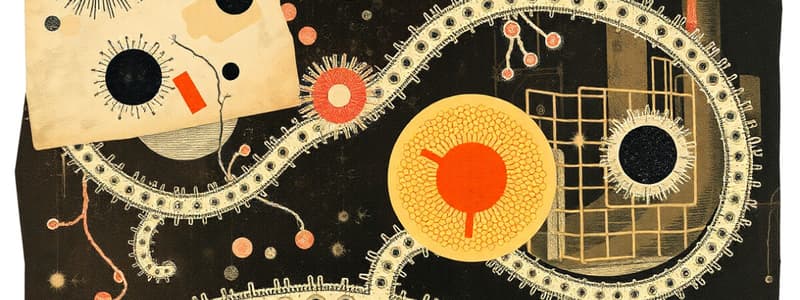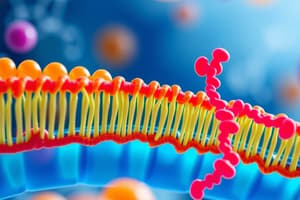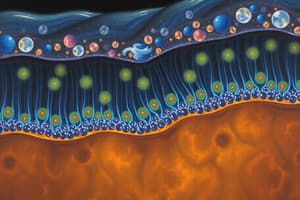Podcast
Questions and Answers
Which of the following structures is not a component of the axoneme in cilia?
Which of the following structures is not a component of the axoneme in cilia?
- Basal bodies similar to centrioles (correct)
- Nine peripheral doublets of microtubules
- Two central singlets of microtubules
- Shaft
Lipofuscin pigments are categorized as which type of cell inclusion?
Lipofuscin pigments are categorized as which type of cell inclusion?
- Exogenous lipids
- Exogenous pigments
- Endogenous pigments (correct)
- Stored food
Which of the following cell types naturally lacks a nucleus?
Which of the following cell types naturally lacks a nucleus?
- Red blood cells (correct)
- Liver cells
- Skeletal muscle cells
- Epithelial cells
What is the primary function of euchromatin within the cell nucleus?
What is the primary function of euchromatin within the cell nucleus?
Which cellular structure is characterized by 9+2 arrangement of microtubules?
Which cellular structure is characterized by 9+2 arrangement of microtubules?
Which cellular component is responsible for generating the majority of a cell's ATP?
Which cellular component is responsible for generating the majority of a cell's ATP?
What is the approximate thickness of the cell membrane?
What is the approximate thickness of the cell membrane?
Which transport mechanism is responsible for the movement of glucose across the cell membrane?
Which transport mechanism is responsible for the movement of glucose across the cell membrane?
Which of the following is a function of the cell coat (glycocalyx)?
Which of the following is a function of the cell coat (glycocalyx)?
Which of the following is NOT a membranous organelle?
Which of the following is NOT a membranous organelle?
What type of molecules are transported across the cell membrane via passive diffusion?
What type of molecules are transported across the cell membrane via passive diffusion?
Which process involves the engulfment of fluid droplets by the cell membrane?
Which process involves the engulfment of fluid droplets by the cell membrane?
What is the primary function of the sodium-potassium pump?
What is the primary function of the sodium-potassium pump?
Which of the following is a key function of the rough endoplasmic reticulum (RER)?
Which of the following is a key function of the rough endoplasmic reticulum (RER)?
What is the primary distinction between primary and secondary lysosomes?
What is the primary distinction between primary and secondary lysosomes?
Which type of cytoskeletal filament is primarily responsible for muscle contraction?
Which type of cytoskeletal filament is primarily responsible for muscle contraction?
What is the diameter of intermediate filaments?
What is the diameter of intermediate filaments?
Which of the following is a function of intermediate filaments?
Which of the following is a function of intermediate filaments?
What protein primarily forms microtubules?
What protein primarily forms microtubules?
Centrioles are composed of how many triplets of microtubules?
Centrioles are composed of how many triplets of microtubules?
Which of the following is a function of microtubules?
Which of the following is a function of microtubules?
What is the function of lysosomes?
What is the function of lysosomes?
What is the diameter of microtubules?
What is the diameter of microtubules?
Which of the following is NOT a function of the smooth endoplasmic reticulum (SER)?
Which of the following is NOT a function of the smooth endoplasmic reticulum (SER)?
What is the primary function of ribosomes?
What is the primary function of ribosomes?
Which of the following describes the structure of the Golgi apparatus?
Which of the following describes the structure of the Golgi apparatus?
Where does the formation of ribosomes take place within the cell?
Where does the formation of ribosomes take place within the cell?
Which of the following best describes the function of the mitochondria?
Which of the following best describes the function of the mitochondria?
A cell that is actively synthesizing proteins for secretion would likely have a large amount of which organelle?
A cell that is actively synthesizing proteins for secretion would likely have a large amount of which organelle?
What is the fate of secretory vesicles that arise from the mature face of the Golgi apparatus?
What is the fate of secretory vesicles that arise from the mature face of the Golgi apparatus?
What is the name given to the spaces formed by the membranes of the mitochondria?
What is the name given to the spaces formed by the membranes of the mitochondria?
Which staining technique is required to visualize the Golgi apparatus using light microscopy?
Which staining technique is required to visualize the Golgi apparatus using light microscopy?
What is the role of transfer vesicles in the Golgi apparatus?
What is the role of transfer vesicles in the Golgi apparatus?
Flashcards
Respiratory Epithelium
Respiratory Epithelium
Tissue found in trachea and bronchi that aids in respiration.
Cell Inclusions
Cell Inclusions
Non-living materials stored in the cytoplasm, including food and pigments.
Exogenous Pigments
Exogenous Pigments
Pigments from external sources, e.g., carotene in vegetables or tattoo ink.
Nucleus Shapes
Nucleus Shapes
Signup and view all the flashcards
Euchromatin vs Heterochromatin
Euchromatin vs Heterochromatin
Signup and view all the flashcards
Cytoplasm
Cytoplasm
Signup and view all the flashcards
Membranous organelles
Membranous organelles
Signup and view all the flashcards
Cell membrane thickness
Cell membrane thickness
Signup and view all the flashcards
Phospholipids
Phospholipids
Signup and view all the flashcards
Active transport
Active transport
Signup and view all the flashcards
Endocytosis
Endocytosis
Signup and view all the flashcards
Mitochondria
Mitochondria
Signup and view all the flashcards
Cell coat functions
Cell coat functions
Signup and view all the flashcards
Functions of Golgi Apparatus
Functions of Golgi Apparatus
Signup and view all the flashcards
Lysosomes
Lysosomes
Signup and view all the flashcards
Primary Lysosomes
Primary Lysosomes
Signup and view all the flashcards
Secondary Lysosomes
Secondary Lysosomes
Signup and view all the flashcards
Microfilaments
Microfilaments
Signup and view all the flashcards
Thick Filaments
Thick Filaments
Signup and view all the flashcards
Microtubules
Microtubules
Signup and view all the flashcards
Centrioles
Centrioles
Signup and view all the flashcards
Cilia
Cilia
Signup and view all the flashcards
Intermediate Filaments
Intermediate Filaments
Signup and view all the flashcards
Inter-membranous space
Inter-membranous space
Signup and view all the flashcards
Matrix space
Matrix space
Signup and view all the flashcards
Ribosomes
Ribosomes
Signup and view all the flashcards
Rough Endoplasmic Reticulum (RER)
Rough Endoplasmic Reticulum (RER)
Signup and view all the flashcards
Smooth Endoplasmic Reticulum (SER)
Smooth Endoplasmic Reticulum (SER)
Signup and view all the flashcards
Golgi apparatus
Golgi apparatus
Signup and view all the flashcards
Polysome
Polysome
Signup and view all the flashcards
Secretory vesicles
Secretory vesicles
Signup and view all the flashcards
Cristae
Cristae
Signup and view all the flashcards
Study Notes
Cell Structure and Function
- Cell: The basic unit of life, possessing various organelles and structures.
- Cytoplasm: The gel-like substance filling the cell.
- Cytoplasmic contents: Comprised of organelles, inclusions, and cell matrix.
- Organelles: Specialized structures with specific functions within the cytoplasm.
- Membrane-bound organelles: Mitochondria, Golgi apparatus, lysosomes, endoplasmic reticulum, peroxisomes, and cytoplasmic vesicles.
- Non-membrane-bound organelles: Ribosomes and cytoskeleton.
- Cell membrane (Plasma membrane): A thin, flexible outer layer of the cell that regulates the passage of materials into and out of the cell.
- 9-10 nm thick
- Not visible in light microscopy
- Trilaminar (3 layers) in electron microscopy
- Chemical structure of cell membrane: Composed of lipids (phospholipids and cholesterol), proteins (integral and peripheral), and carbohydrates (glycoproteins and glycolipids).
- Functions of cell membrane:
- Exchanges of materials
- Endocytosis (Phagocytosis for solid, Pinocytosis for fluids)
- Exocytosis
- Sodium-potassium pump
- Functions of cell coat
Mitochondria
- Definition:
- Membrane-bound organelles.
- Powerhouse of the cell responsible for energy production.
- Structure (L.M.): Rods, granules, filaments
- Structure (E.M.): Rod-shaped or spherical, covered by two membranes.
- Outer membrane: smooth
- Inner membrane: forms cristae. Has an inter membranous space.
- Matrix space: contains DNA, RNA, ribosomes, and proteins.
- Function: Produce ATP (energy).
- Number: Variable depending on cell type and function.
Ribosomes
- Definition:
- Non-membrane-bound organelles.
- Sites of protein synthesis.
- Structure (L.M.): Basophilic (RNA containing)
- Structure (E.M.):
- Small particles, two subunits (large and small)
- Composed of rRNA and proteins.
- Formed within nucleolus.
- Released through nuclear pores
- Function: Protein synthesis.
- Types: Free ribosomes (protein synthesis into cytosol) and attached ribosomes (protein synthesis for secretion or incorporation into membranes).
Endoplasmic Reticulum (ER)
-
Types:
- Rough ER (RER): studded with ribosomes; involved in protein synthesis destined for secretion or membrane incorporation.
- Smooth ER (SER): lacks ribosomes; involved in lipid synthesis, detoxification, carbohydrate metabolism.
-
Structure (EM): Interconnecting tubules and cisternae (flattened sacs) to form a network.
-
Function (RER): Protein synthesis, particularly proteins destined for transport or secretion.
-
Function (SER): Synthesis of steroid hormones, glycogen metabolism, detoxification of toxins, and regulation of calcium in skeletal muscles.
Golgi Apparatus
- Structure (LM): Pale area near nucleus in routine stains; visible with silver staining
- Structure (EM): Composed of flattened sacs called saccules, transfer vesicles, secretory vesicles
- Function:
- Chemical modification of proteins synthesized by ER.
- Packaging of proteins into vesicles (for secretion).
- Secretion of proteins (vesicles move along cytoskeleton to plasma membrane).
- Formation of coated vesicles and lysosomes.
Lysosomes
- Definition: Membrane-bound organelles containing hydrolytic enzymes.
- Structure: Round, electron-dense bodies.
- Types:
- Primary lysosomes: Newly formed lysosomes coming from the Golgi.
- Secondary lysosomes: Primary lysosomes fused with other vesicles to digest material.
- Function:
- Phagocytosis of foreign particles/bacteria
- Pinocytosis & digestion of fluids
- Digestion/breakdown of old organelles.
Cytoskeleton
- Components: Microtubules, microfilaments, and intermediate filaments.
- Microtubules (25nm): Pipe-like structures, made from tubulin protein.
- Function: Support cell shape, transport substances, form cilia/flagella/centrioles, mitotic spindle.
- Microfilaments (7 nm ): Thin, contractile filaments (actin).
- Function: Muscle contraction, support for microvilli, cleavage furrow during cell division.
- Intermediate filaments (10nm): Support cell shape, transmission of forces (smooth muscles), and involved in tumor identification.
Centrioles and Centrosome
- Structure: Paired perpendicular centrioles (made of microtubules).
- Function: Organize microtubules for cell division (mitotic spindles) and basal bodies for cilia.
Cilia
- Definition: Hair-like projections on the cell surface.
- Structure: 9 peripheral microtubule doublets and 2 central microtubules.
- Function: Movement of fluids/substances across the cell surface
- Location: Respiratory system, female reproductive system
Cell Inclusions
- Definition: Non-living materials stored in the cytoplasm.
- Types:
- Stored food (glycogen, lipids)
- Pigments (exogenous and endogenous)
Nucleus
- Structure (LM):
- Number: Single (mononucleated), binucleated, multinucleated, or anucleated.
- Size: Variable (3-14 µm)
- Shape: Spherically, oval, kidney-shaped, lobed (segmented), horse-shoe shaped.
- Staining: Basophilic (due to DNA and RNA).
- Appearance: Open-face (vesicular) or condensed.
- Structure (EM): Nuclear envelope (membrane), nucleolus, chromatin, nuclear sap.
Chromatin
- Definition: Basophilic material forming chromosomes.
- Structure: Nucleoprotein (DNA + histone proteins)
- Types: Euchromatin (extended, active) and heterochromatin (condensed, inactive).
Studying That Suits You
Use AI to generate personalized quizzes and flashcards to suit your learning preferences.




